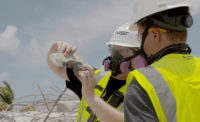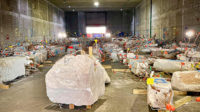
The distance from the White House entrance walkway where presidents sometimes greet reporters, to Champlain Towers in Surfside, Fla., where life is about the beach, is about 1,050 miles and just shy of a 15-hour drive, depending on traffic.
The distance between the two disappeared on June 24, when President Biden emerged from the White House with a group of Senators from both parties to say they had reached agreement on the framework of a $579-billion infrastructure spending measure.
As they spoke, rescue crews were beginning to pick through the debris pile of Champlain Towers South, the 12-story condominium apartment complex that had partly collapsed early that morning. They were searching for more than 150 people entombed there. Many may not even have their remains recovered and identified.
The Champlain Towers collapse is the worst accidental partial building failure since the Kansas City Hyatt Regency Hotel walkway in 1981, which killed 114 people.
It is understandable to compartmentalize what happened to a privately owned, 40-year-old reinforced-concrete Florida building on sandy soil in a salty environment, from the much different targets of a national infrastructure overhaul. The juxtaposition of the events in the media joins them in the public mind, and that could have implications for the infrastructure measure.
The juxtaposition of the events in the media joins them in the public mind, and that could have implications for the infrastructure measure.
The news from Washington in the days after the infrastructure pact announcement involved a telling political flap—a seemingly minor event considering the tragedy playing out in Florida.
Without any Republicans in sight, and with the bipartisan “pact” recently announced, President Biden suddenly vowed not to sign or support the big infrastructure spending measure unless the funding for that other kind of infrastructure, social or human infrastructure to support families, and money to counter climate change, was also approved by the Democratic Congressional majorities.
That transformed the happy White House press briefing into a meaningless exercise and exposed the moderate Republicans involved in the deal to flak from more obstructionist party members. Then Saturday the White House walked back the president’s comments, delinking physical and social infrastructure.
“There’s nothing like a disaster to focus the mind,” NBC News journalist Joshua Johnson said on Meet the Press in evaluating the package’s chances of adoption. He implied that what had happened in Florida had subtly redirected the emotional currents surrounding the fragile infrastructure spending pact in a way that could increase its chances of passing.
Could the nightmarish events in Surfside do more than the previous week’s Washington, D.C. -area pedestrian bridge collapse, more than May’s cracked and closed I-40 Mississippi River bridge, more than dozens of below-average grades from the American Society of Civil Engineers? So far, all the prior precursor events and other evidence that tells us and shows us that our national infrastructure was the equivalent of a dented 1980 Ford Granada, clunky and prone to breakdowns, had not managed to weaken the political obstructions preventing infrastructure funding.
Buildings Are Safer
The cable channels toggled between the two stories all day and all night, and newspapers, for those who still look at them, situated both on the front pages.
Together, they blithely erased the distance from Pennsylvania Avenue to Collins Avenue and the debris in Surfside.
With the general improvement in safety provided by better fire-resistant materials and sprinkler systems, newer buildings are about as safe a place as you can be at any one moment of the day. The biggest dangers you encounter are in the bathtubs, where slips and falls can be very bad, and in the kitchen, where you can compromise your health with innumerable dangerous foods and beverages.
But Champlain Towers South was constructed before Florida enacted regulations requiring designs to prevent progressive collapse. Some buildings are less safe than others.
Americans have longed for infrastructure renewal and the agreed federal funding pact has little for buildings. But Champlain Towers is a flashing red light about the expiration date having passed on much of the constructed environment. Before any other agonizing reminders emerge, we had better snap into action to fix what we can.






Post a comment to this article
Report Abusive Comment